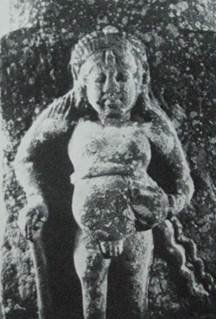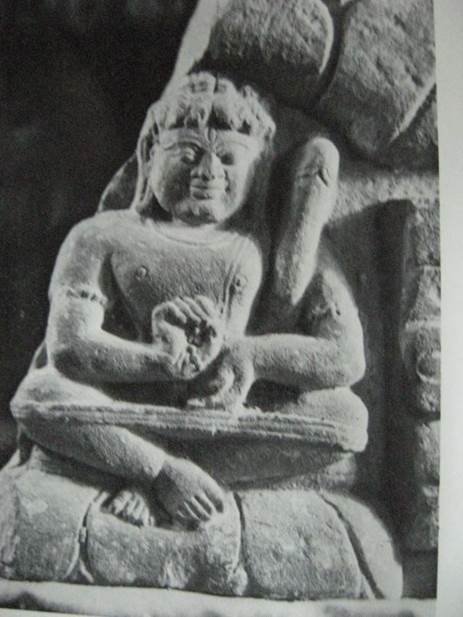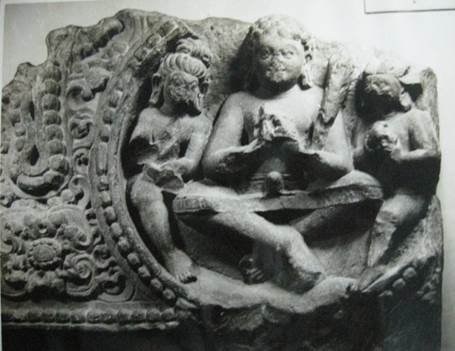Lakulisha-Pashupata (Philosophy and Practice)
by Geetika Kaw Kher | 2012 | 86,751 words
This study discusses the dynamics between the philosophy and practice in the Lakulisha-Pashupata order. According to the cave temples of Elephanta and Jogesvari (Jogeshwari), Lakulisa was the 28th incarnation of Shiva, and Pashupata Shaivism his doctrine, of which the Pasupatasutra represents the prominent text detailing various ritual practices (v...
Kusika and the Ascetic Aspirants: Early form of Lakulisa-Pasupata order
Kusika, considered as the first disciple of Lakulisa finds mention in Pasupata Sutra(Pasupata-sutra)[1] and Pancarthabhasya (Pancharthabhasya)2. Both these texts talk about his getting directly initiated by Lakulisa in Ujjain. The Mathura Pilaster Inscription,(380CE) published by Bhandarkar in 1933 threw considerable light on this lineage and on some of their practices.The inscription talks about a Saivite teacher Uditacarya, described as tenth in apostolic succession from Kusika, who established two lingas in the memory of his teacher Upamitacarya and teacher’s teacher Uditacarya in the Guruayatana, the gallery where memorials were kept to commemorate various gurus of the lineage.
The place seems to have been something like a Kusana devakula and the presence of such spaces to commemorate ancestors since ancient times is corroborated by Bhasa’s play “Pratima Nataka” based on Ramayana. Bhandarkar[2] suggests that the term “gurupratimayuto”(choubey 52) should be read in space illegible after the term guru in the above mentioned inscription, and he further contends:
“apparently the representations showed as if Upamita and Kapila were standing each with a Linga on the head”
Though Bhandarkar’s suggestion about the missing words seems probable, after discussion with some Sankritists I came to the conclusion that the word “yuto” only means “along with” so the inscription suggests that the linga along with the representation of the revered teachers was established in the sacred space with due rites. I am tempted to see these lingas as “mukhalingas”, as they also were called as Upamitesvara and Kapilesvara respectively. Moreover this contention is further supported by the presence of the Lakulisa images from Karvan. The concept of Mukhlingas will be dealt in detail in the later section on Siva Lingas but one can definitely see the importance of this philosophical concept right in early years of Lakulisa-Pasupata order.
To set up a lingam to represent a dead teacher was a practice followed by aspirants of this order in various other places too. In the Bharati Matha of Bhubaneswar, the same practice is still being followed. A Gurvayatana has sprung up within its compound as a result of this practice.
As many as fifteen miniature temples of sand stone and literite are now there in the compound, each of which contains a linga. In the open space and the niche, a number of lingams are to be found also and most of these temples were constructed under Bhauma rule, which started around 736CE and were great patrons of Pasupata Saivism.
Many more temples are still buried in the kitchen garden according to the Mahanta of the Matha. It can reasonably be concluded that the origin of the Matha goes to the time of the earliest standing temples, since each of the lingas represents a generation of teachers. In the seventh chapter of the Ekamra Purana it is clearly mentioned that Pasupatas were highly responsible for constructing most of the temples in and around Bhubaneswar and it mentions that Yama, gave a splendid matha to a Pasupatacharya who lived in the close vicinity of the temple and who was also the builder of the temple.
Interestingly Kusika is connected to the famous sage Visvamitra who is supposed to have belonged to Kausika gotra.Yaska too subscribes to this and considers Kusika to be the “father” of Visvamitra. Connected with Audumbaras on one hand and Kusika on the other Visvamitra comes across as an important figure in Lakulisa-Pasupata Saivism. The argument is supported by the fact that his image is given due importance in the newly constructed temple at Karvan, hence pointing at his importance in this tradition. Born a Ksatriya he was later converted into a Brahmin by his deeds which was possible easily in Pasupata order as it was open for all castes.
The Udaipur Inscription of Naravahana (V.S 1028= 971CE) refers to Kusika and records that ascetics who besmear their bodies with ashes and wear barks and have matted hair, appeared in his line. This important disciple finds mention in “Saddarsana Samuchchaya” of Haribhadra Suri and commentary on Ganakarika (GanakarikaK) too. As comes across through all these descriptions the followers of this order were usually ascetics and mendicants for whom probably the injunctions of Pasupata-sutra were written. The teaching and learning aspect seems to be of supreme importance for them.
Haribhadra Suri[3] mentions eighteen Tirthesas headed by Lakulisa and Kusika. The same list is also enumerated by Bhava Sarvajna[4] in his commentary on Ganakarika.In this context of continous teacher-student lineage it would be interesting to look at the figure on the Mathura Pillar inscribed in the year 61 of the Gupta era (AD 380) sculpted with a trident. The base shows a potbellied standing figure, nude with two hands, leaning on a staff and with a third eye. D.R.Bhandarkar believes the figure to be Lakulisa but Agrawala points to the absence of the urdhvaretas and hence disagrees with the above contention. U.P Shah suggests that the pillar inscription invokes Bhagwan Danda which could very well have been a personification of an attribute (ayudha purusa) “danda”of Lakulisa and could have been used as a metonymy for the saint-teacher.

[Illustration 16. Bhagvana Danda (inscribed), Mathura Pillar, 380CE,Mathura Govt.Museum]
Here I would like to stress that it need not be established as an image of Lakulisa in particular but it might have been a portrait of a teacher from the same lineage. Though the third eye clearly hints at superhuman aspect it could very well have been an image of a guru who had attained Bhairavahood, a concept not alien to early forms of Saivism. A dead teacher was visualized as having merged with Siva and in a way a part of the Lord himself. In metaphysical terms he lost his human body only to become part of a divine consciousness and attained Rudrahood.
The earliest images of Lakulisa from Mathura datable to 5th -6th CE show him seated with two arms. Holding his club in the crook of his arms with a yogapatta on his knees and a rosary which he is probably meditating with,he appears very much like a Saivite teacher with no signs of apparent divinity in him. Marked with a sign of third eye and invested with a sacred thread, he appears calmly in state of teaching. Though this early and interesting image is conspicuous because of its absence of erect phallus, here we can see the danda itself has taken a form of a linga probably combining both the aspects.
 [Illustration 17. Lakulisa,Mathura 5th -6th CE,State Museum Lucknow] |
 [Illustration 18. Lakulisa with two disciples, Svamighat Mathura 5thCE, ASI] |
These early images present him clearly as a teacher, many a times seen with his disciples flanking him on both sides. Here Lakulisa maintains his human essence and comes across as a guru rather than a deity. Another lineage of Lakulisa deeply connected with this pure teaching-learning aspect is the Ananta lineage.
Footnotes and references:
[1]:
[2]:
Bhandarkar, D.R “Mathura Pillar
[3]:
Choubey,M C. Lakulisa in Indian Art and Culture. Delhi:Sharda Publishing House, 1997 p.78
